While travelling through the North Island in New Zealand, I caught up with agricultural contractor Daljeet Singh, who is based near Palmerston North. Daljeet owns two of the three Claas Cougar self-propelled mowers in New Zealand. Each Cougar mows ahead of one silage harvesting outfit. Despite running two outfits, Daljeet has only one set of drivers, meaning only one outfit is ever in action. Confused? So was I. 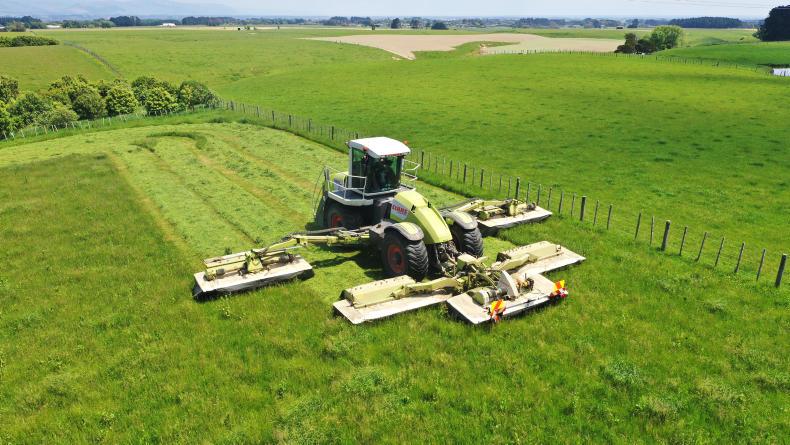
Claas entered production of the Cougar in late 2004 and ceased production in 2009, building a total of 70 units.
Daljeet cuts grass in two distinct areas. At the beginning of the season, the two outfits start off 50-60km away from each other. As the season progresses, one outfit will continue to work its way north while the other works south, eventually getting to over 200km away from each other.
To overcome mixed weather in these micro-climates, he has one outfit in each of the two regions. To avoid downtime, while keeping his full-time staff busy, Daljeet always has one outfit on the go. The machines don’t leave their respective regions, but the staff travel between them.
Daljeet was the first person in New Zealand to own a Cougar and today runs two of the three in the country.

When in transport mode, the cab by rotates 180°, the same as the Xerion.
“Over the years I used to run John Deere 4955s and 4960s on butterfly mowers. From here, I moved to Claas foragers converted to run triple mowers. I still run one of these today. These worked well, but I couldn’t get the required output to keep the grass cut in front of hungry 900 series foragers. On a trip to the Claas factory in Germany in 2010, I saw a Cougar in action. It really impressed me and left a lasting impression. I got in contact with a German machinery dealer in 2013 and he sourced me a 2007 machine. I saw some pictures of it and took a chance. After going really well, a 2009 ex-demo machine came up for sale a number of years later and I picked it up at good value,” explained Daljeet.
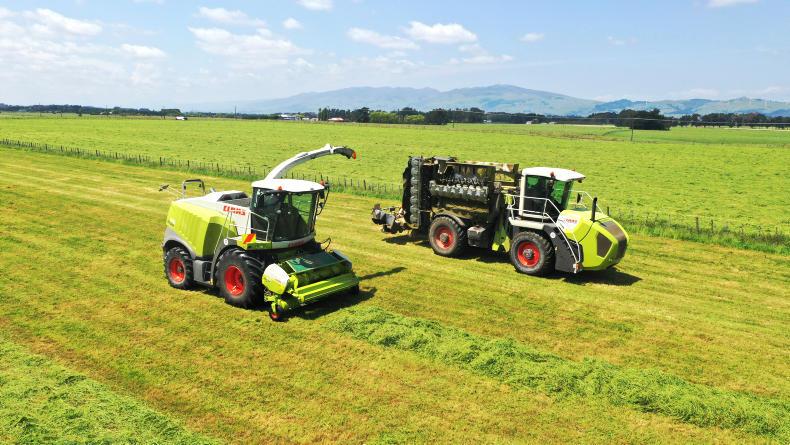
“Whoever designed the Cougar did an awesome job," said Dalgy.
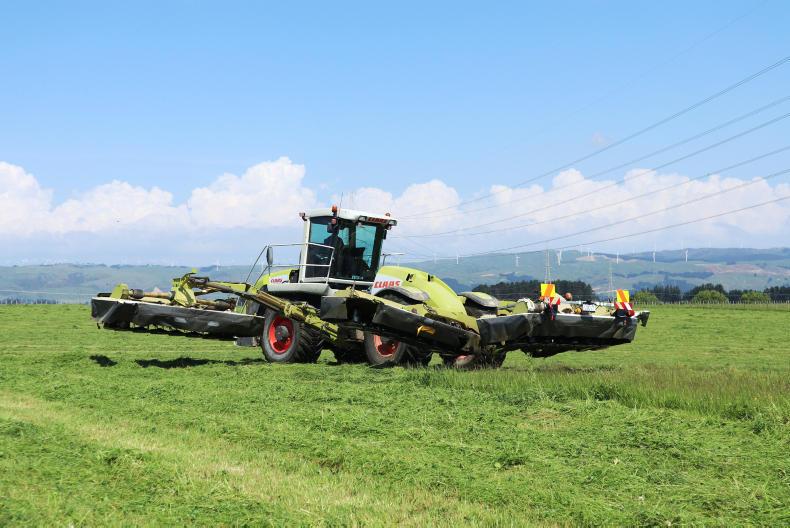
Dalgy said: "Just the other day, we mowed 83 acres in just over an hour and a half”.
Weighing in at around 18.5t, the Cougar is obviously a large machine. It’s 11.5m (38ft) long, 3.96m (13ft) high and from 3m to 3.5m (9.8–11.5ft) wide, depending on the tyre used.
“Despite its weight, the Cougar is a very good machine on soft ground. For the most part, they work well on hills. However, when things get greasy, it can be dangerous as the Cougars have a tendency to slide, but they are better on hills any day than a forager with mounted mowers. The only other downside to the Cougar is that the two inside mowers don’t like dips or hollows in the ground. If the operator isn’t careful, the mowers will dig into the ground.
“At a glance, one would think the Cougar is big and awkward, but it’s not – it’s surprisingly maneuverable. Most of the paddocks we cut are around 4-5ha (10-12 acres) and our average job is around 40ha (99 acres). Narrow gateways and cow lanes are the only challenges this machine faces for the most part,” noted Daljeet. 
Those used to Jaguars will recognise this cab, it's the exact same.
Power train
The Cougar is powered by a Mercedes-Benz six-pot engine. With a maximum output of 480hp, this is the same engine that Claas used in a number of its foragers during the same era. Equipped with a similar hydrostatic transmission as what’s used in foragers, mowing speeds of up to 21km/h were achievable while road speed was 40km/h.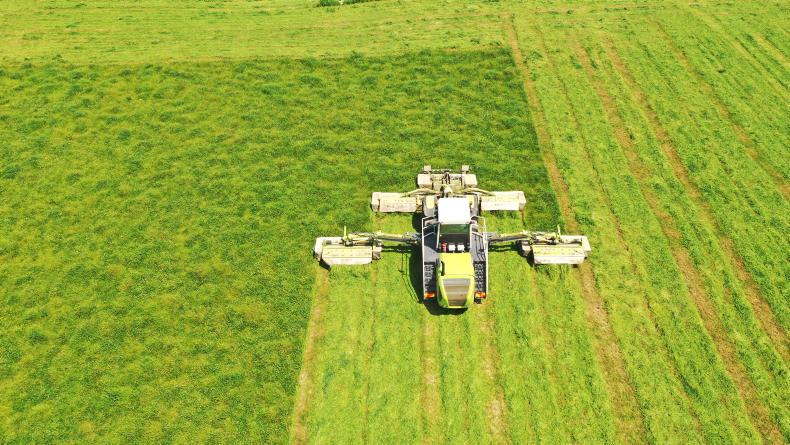
“Lack of power is rarely an issue, but much of the grass we cut isn’t overly heavy. The engine usually only comes under load when working on hills. I was very impressed with how efficient the Cougar is on fuel. Depending on the crop, one tank (960 litres) will mow from 160-200ha (395-495 acres). The output capacity of these machines is also phenomenal. Just the other day we mowed 83 acres in just over an hour and a half,” explained Daljeet. 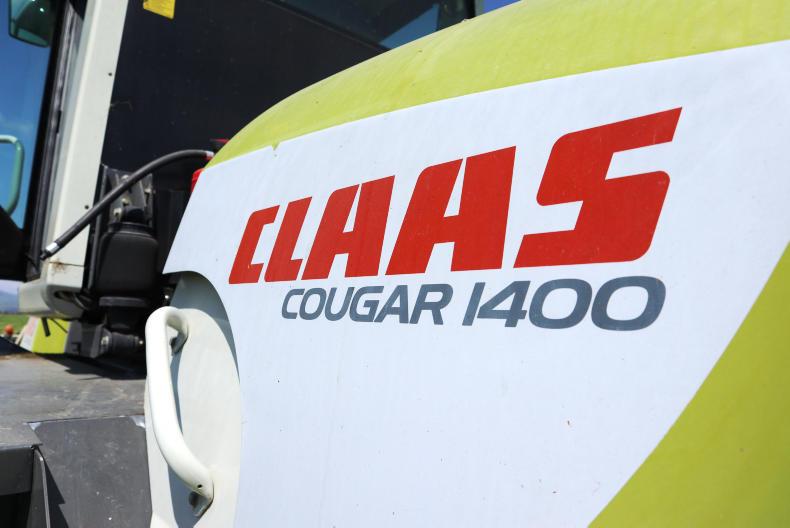
The steering system for the Cougar was sourced from the Xerion
Functionality
The Cougar is equipped with five suspended mowers. It has the 8550C triple combination unit at the front, the same mowing unit that was later fitted to many foragers. Meanwhile, the two side mowers are mounted on telescoping booms that sit between the axles. Each mower can be individually controlled and moved in all directions. The mowers featured hydro-pneumatic cutterbar suspension. They also had a break-back safety system. 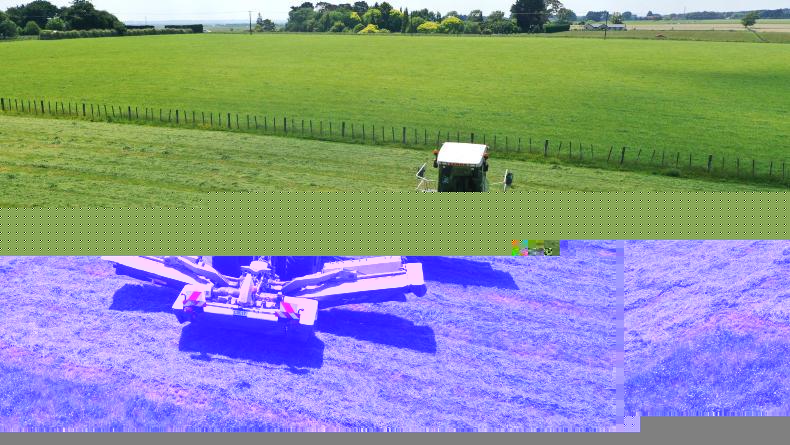
The Cougar features the same cab as Claas used on the Jaguar. While in field mode, the operator is looking down at the mowers, easily able to keep an eye on all five. When in transport mode, the cab rotates by 180°, the same as the Xerion. This means the lifted and folded front and side mowers are located at the vehicle’s rear. 
The two outer side mowers are mounted on telescoping booms that sit between the axles.
“Many people that see the Cougar say the running costs must be very high, but in fairness they’re not. For the most part, these are one-driver machines and very well cared for. Because it’s cutting so much in one run, there’s no need to drive them too hard. Each winter, the operator goes through them from top to bottom. We often strip down various parts of the running gear and replace many important bits and pieces such as seals, bearings and hydraulic hoses to minimise the chance of downtime when things are busy. Each machine is cutting around 2,000ha (4,942 acres) per year. The running costs have been around $3,000-5,000 per year.
“Whoever designed the Cougar did an awesome job – even today, there’s nothing else on the market to touch them. The way they open and fold out so easy, they were just so ahead of their time, it’s a real shame they stopped building them. I’ve no intention of selling the Cougars, I’m going to keep them mowing for as long as I can. 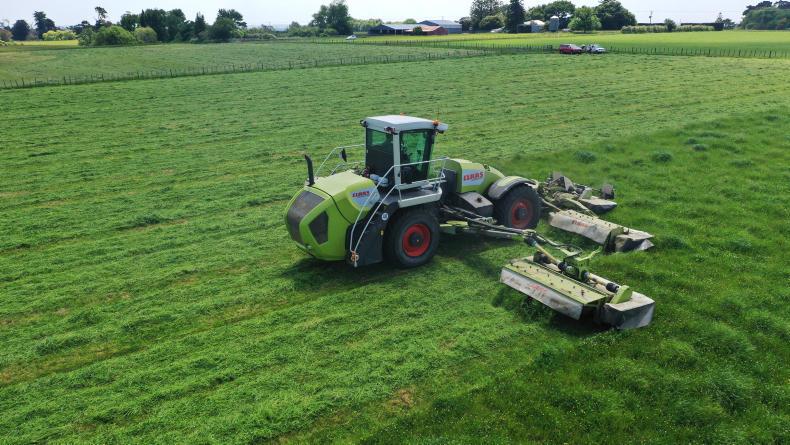
The Cougar is powered by a 480hp Mercedes-Benz six pot engine.
The spec
Model: Cougar 1400
Engine: Mercedes-Benz six-cylinder
Transmission: hydrostatic
Mowing width: 14m (46ft)
Launched: Agritechnica 2003
Years in production: 2004-2009
Number of units built: under 100
Daljeet’s mowing outfit: two Claas Cougars, one Claas Jaguar 850 with 8550C mounted mowers
Daljeet’s foragers: Claas Jaguar 980, 970, and two 870s.


While travelling through the North Island in New Zealand, I caught up with agricultural contractor Daljeet Singh, who is based near Palmerston North. Daljeet owns two of the three Claas Cougar self-propelled mowers in New Zealand. Each Cougar mows ahead of one silage harvesting outfit. Despite running two outfits, Daljeet has only one set of drivers, meaning only one outfit is ever in action. Confused? So was I. 
Claas entered production of the Cougar in late 2004 and ceased production in 2009, building a total of 70 units.
Daljeet cuts grass in two distinct areas. At the beginning of the season, the two outfits start off 50-60km away from each other. As the season progresses, one outfit will continue to work its way north while the other works south, eventually getting to over 200km away from each other.
To overcome mixed weather in these micro-climates, he has one outfit in each of the two regions. To avoid downtime, while keeping his full-time staff busy, Daljeet always has one outfit on the go. The machines don’t leave their respective regions, but the staff travel between them.
Daljeet was the first person in New Zealand to own a Cougar and today runs two of the three in the country.

When in transport mode, the cab by rotates 180°, the same as the Xerion.
“Over the years I used to run John Deere 4955s and 4960s on butterfly mowers. From here, I moved to Claas foragers converted to run triple mowers. I still run one of these today. These worked well, but I couldn’t get the required output to keep the grass cut in front of hungry 900 series foragers. On a trip to the Claas factory in Germany in 2010, I saw a Cougar in action. It really impressed me and left a lasting impression. I got in contact with a German machinery dealer in 2013 and he sourced me a 2007 machine. I saw some pictures of it and took a chance. After going really well, a 2009 ex-demo machine came up for sale a number of years later and I picked it up at good value,” explained Daljeet.

“Whoever designed the Cougar did an awesome job," said Dalgy.

Dalgy said: "Just the other day, we mowed 83 acres in just over an hour and a half”.
Weighing in at around 18.5t, the Cougar is obviously a large machine. It’s 11.5m (38ft) long, 3.96m (13ft) high and from 3m to 3.5m (9.8–11.5ft) wide, depending on the tyre used.
“Despite its weight, the Cougar is a very good machine on soft ground. For the most part, they work well on hills. However, when things get greasy, it can be dangerous as the Cougars have a tendency to slide, but they are better on hills any day than a forager with mounted mowers. The only other downside to the Cougar is that the two inside mowers don’t like dips or hollows in the ground. If the operator isn’t careful, the mowers will dig into the ground.
“At a glance, one would think the Cougar is big and awkward, but it’s not – it’s surprisingly maneuverable. Most of the paddocks we cut are around 4-5ha (10-12 acres) and our average job is around 40ha (99 acres). Narrow gateways and cow lanes are the only challenges this machine faces for the most part,” noted Daljeet. 
Those used to Jaguars will recognise this cab, it's the exact same.
Power train
The Cougar is powered by a Mercedes-Benz six-pot engine. With a maximum output of 480hp, this is the same engine that Claas used in a number of its foragers during the same era. Equipped with a similar hydrostatic transmission as what’s used in foragers, mowing speeds of up to 21km/h were achievable while road speed was 40km/h.
“Lack of power is rarely an issue, but much of the grass we cut isn’t overly heavy. The engine usually only comes under load when working on hills. I was very impressed with how efficient the Cougar is on fuel. Depending on the crop, one tank (960 litres) will mow from 160-200ha (395-495 acres). The output capacity of these machines is also phenomenal. Just the other day we mowed 83 acres in just over an hour and a half,” explained Daljeet. 
The steering system for the Cougar was sourced from the Xerion
Functionality
The Cougar is equipped with five suspended mowers. It has the 8550C triple combination unit at the front, the same mowing unit that was later fitted to many foragers. Meanwhile, the two side mowers are mounted on telescoping booms that sit between the axles. Each mower can be individually controlled and moved in all directions. The mowers featured hydro-pneumatic cutterbar suspension. They also had a break-back safety system. 
The Cougar features the same cab as Claas used on the Jaguar. While in field mode, the operator is looking down at the mowers, easily able to keep an eye on all five. When in transport mode, the cab rotates by 180°, the same as the Xerion. This means the lifted and folded front and side mowers are located at the vehicle’s rear. 
The two outer side mowers are mounted on telescoping booms that sit between the axles.
“Many people that see the Cougar say the running costs must be very high, but in fairness they’re not. For the most part, these are one-driver machines and very well cared for. Because it’s cutting so much in one run, there’s no need to drive them too hard. Each winter, the operator goes through them from top to bottom. We often strip down various parts of the running gear and replace many important bits and pieces such as seals, bearings and hydraulic hoses to minimise the chance of downtime when things are busy. Each machine is cutting around 2,000ha (4,942 acres) per year. The running costs have been around $3,000-5,000 per year.
“Whoever designed the Cougar did an awesome job – even today, there’s nothing else on the market to touch them. The way they open and fold out so easy, they were just so ahead of their time, it’s a real shame they stopped building them. I’ve no intention of selling the Cougars, I’m going to keep them mowing for as long as I can. 
The Cougar is powered by a 480hp Mercedes-Benz six pot engine.
The spec
Model: Cougar 1400
Engine: Mercedes-Benz six-cylinder
Transmission: hydrostatic
Mowing width: 14m (46ft)
Launched: Agritechnica 2003
Years in production: 2004-2009
Number of units built: under 100
Daljeet’s mowing outfit: two Claas Cougars, one Claas Jaguar 850 with 8550C mounted mowers
Daljeet’s foragers: Claas Jaguar 980, 970, and two 870s.















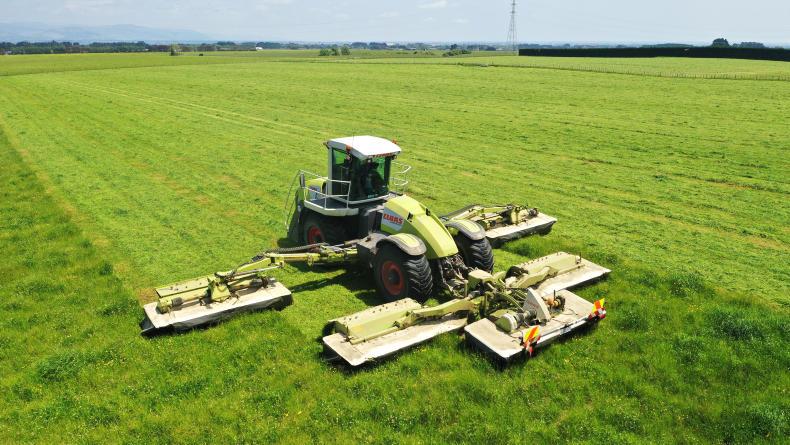




 This is a subscriber-only article
This is a subscriber-only article







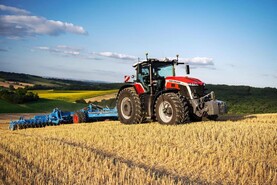
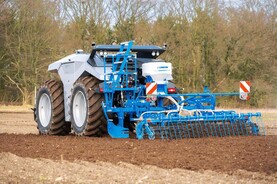
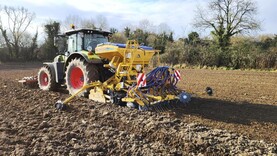
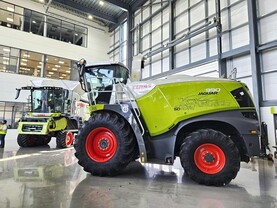
SHARING OPTIONS: